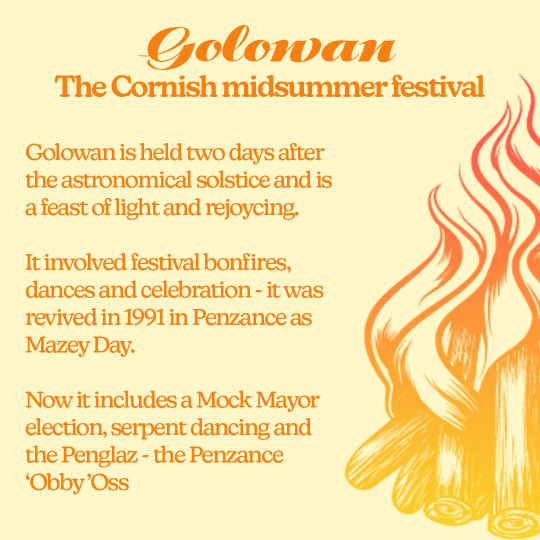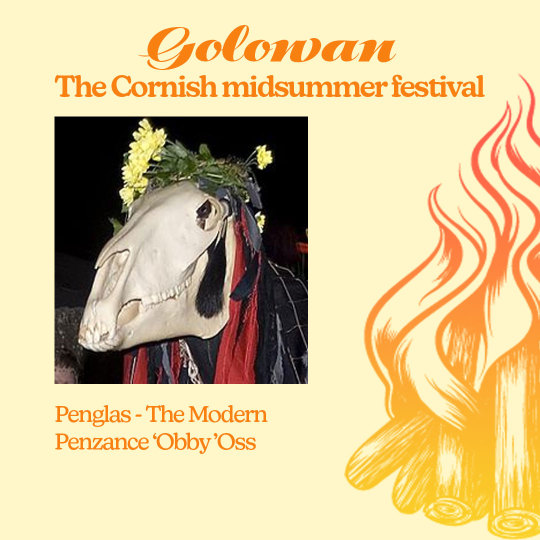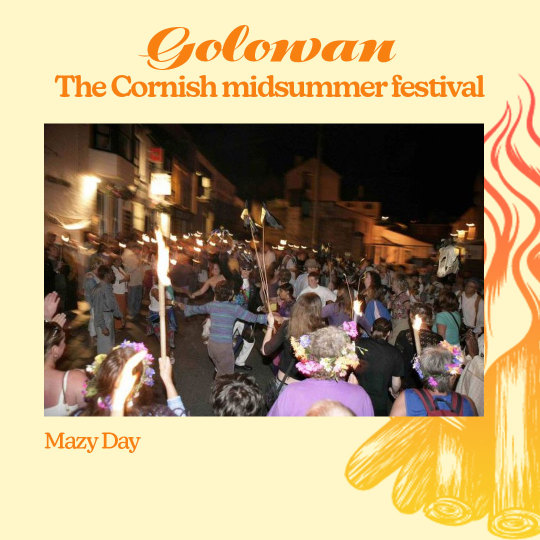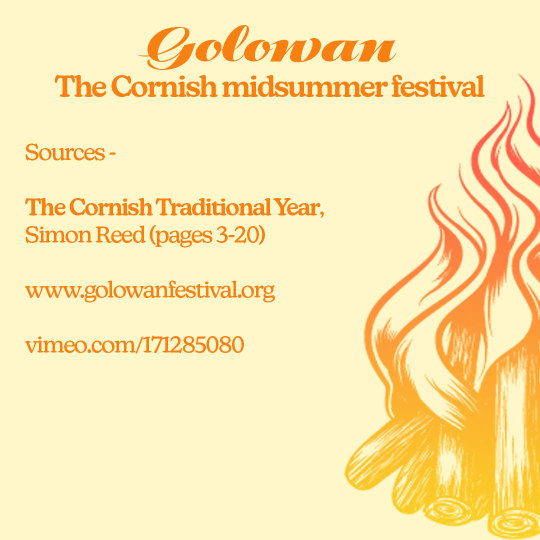#cornish folkcraft
Text
if "cornish witch" makes a comeback as an aesthetic or cool grab bag 'tradition' for witches outside of Cornwall I'm going to get out me whacking stick
#cornish witch#cornish witchcraft#cornish pagan#cornish folk witch#cornish folkcraft#cornish folklore#cornish folk religion#cornish folk magic
2 notes
·
View notes
Text
Sprowl - as written about by Gemma Gary
Page 62 - 63
The Cunning path is first trod out in the land where the ‘novice pellar’ is called to go in search of the natural forces that will both empower and inform their craft. For the Cornish witch, one of the most potent and useful forces is known as the Red Serpent or Sarf Ruth. This is the spirit force or ‘sprowl’ that flows within the land, animates all living things and empowers the spirit within all natural things; for traditional Cornish witchcraft is an animist path which acknowledges spirit within such things as stones, streams and buildings.
Detecting and harnessing the serpentine flow is of great importance to the pellar, and they must know the ways to this and the places where this force will be best drawn forth. The desire to seek these forces and draw upon them, and indeed the ability to do so, should be naturally held within the true witch. It is a thing ‘deeply known’ and the ways of it are not easily put into words. Often it is just a case of fine tuning the familiar senses, desires and abilities within those who are starting their way along the path, rather than something alien having to be learned from scratch.
It is a regular practice of witches in Cornwall to walk out into the land to gather ‘sprowl’ to aid and empower their craft, such journeys may be known as ‘walking the serpent path’; a path of power and chthonic gnosis. The witches are very sensitive to the landscape in which they live and they know well the places of power around them where the sprowl can best be drawn forth and stored for later use; this is how the Cornish witch gathers power. The highly important tool - the witch’s staff is the traditional companion upon the serpent path, as the sprowl may be drawn forth and stored within this as well as within the body of the witch. The winding serpent-like paths that flow and meander through fields and valleys, alongside and through the magical thorn-hedge, following streams or along the towering and dramatic sea cliffs, are commonly travelled by the witch who ‘picks up’ sprowl along the way. These serpentine tracks also have magical & meditative uses. The hills, boulder strewn carns and other high places, where the ser[ent will coil cone-like in the land, are also places where this potent force may be accessed in abundance as well as within the ancient stone circles where the serpent is literally ‘danced alive’ by the circumambulations of the witch.
Page 99
[On traditional craft magical tools]
Natural materials not only contain the very sprowl or spirit of the landscape in which they were found, but more easily become a vessel and conduit for magical forces employed and directed and the working sprowl of the practitioner. Such tools become a magical extension of the practitioner's being and are seen as gifts directly from the land and the Old Ones.
Page 137
[On colours and animals sacred in cornish witchcraft]
Red is ruled by the serpentine fire in the land, it is magic of potency and empowerment, to charge an item, being or place with generative sprowl is an act of red magic, as are workings of sexual energy and the laying down or directing of protective spirit forces. The familiar spirit of red magic is the red serpent.
Page 149
[Working incense to raise sprowl]
Serpent Smoke
A general working incense for the gathering, raising and direction of sprowl. It is employed in acts of empowerment and all rites and workings aided by the virtues of the eastward road:
Bryony root ½ tsp, Cinnamon oil 15 drops, Clove oil 30 drops, Colophony 1 ½ tsp, Dragons Blood 2 tsp, Geranium oil 5 drops, Ginger powdered ½ tsp, Madder root 3 tsp, Patchouli oil 12 drops, Pine needles 1 tsp, Rue 1 tsp, Sloe berries 1 tsp, Wormwood 1 tsp, Alum 1 ½ tsp.
4 notes
·
View notes
Text
What to do with an Allan Apple?
For every Sunday leading up to Allantide I'm going to make every effort in the world to post a blog entry detailing some specific part of Cornish folk customs around the event! Today is the function of Allan Apples in divination, along with other fun divination methods!
An Allan Apple is any highly shined, big red apple. There's no requirements beyond that! They're easy to get hold of and their use is central to Allantide! Traditionally there were Allan Apple markets where people could go and buy their apples for the festival.
Before the discussions of apples and divination it's important to confirm what Allantide is!
Allantide, also translated to Kalan Gwav (first day of winter), Nos Kalan Gwav (first eve of winter) or Dy' Halan Gwav (day of the first day of winter), is analogous to Hallowe'en or Hollantide of England and Cymru, or Samhain from Éire. As a result it's in-keeping with the themes of death, open gateways, divination and the dark of winter. More controversially (only because it divests the day and night of it's Christian attachments) it is also a festival of magic and charms. It's a particularly rich time for the appearance of ghosts, spirits and the Pobel Vean. Along with most Cornish festivals, fire and beacons are also very important.
Back to the apples - how to they factor into Allantide aside from the name? Divination...of course! The most important function of an Allan Apple was fortelling the users true love. They were generally given as gifts, so was a fairly easy affair. Older girls and young women would simply tuck the apple under the pillow during the night and sleep on it - that was enough to induce dreams of their future lover. Another more expansive use was to tell general fortune for the rest of winter, and even young children involved themselves in that.
Gifts of Allan Apples also brought luck to the receiver even if their divinatory use wasn't fulfilled!
Along with the apples, young hopefuls would throw molten lead or other metals into cold water and divine their future lovers occupation from the shapes they took - a fish would be a fisherfolk, for example. There was also the tradition of couples throwing walnuts onto an open fire to ensure their fidelity to each other throughout the coming year.
In more modern times the gifting and use of all of these divination methods fell out of favour, largely in part to increased Christianisation of Cornwall. It's starting to resurface more and more with the resurgence of folk witches and folk traditions, with apples being used as more than just divination - some offer them as gifts to ancestors passed on or as an offering to Ankow or the newly empowered Bucca Dhu.
A song has been written by a delightful Cornishwoman called Brenda Wootten and it can be found here: https://www.youtube.com/watch?v=SIGkuNyjTdM
Next Sunday's post will be about magic and superstition in Cornwall!
crossposted to pysksos, my cornish folkcraft blog - https://pysksos.blogspot.com/2021/10/take-allan-applecornish-divination.html
#allantide#halloween#divination#apples#divination methods#cornish witch#cornish witchcraft#folk witch#folk witchcraft#folk magic#folk holiday#cornish folk magic#celtic folk holiday#celtic polytheism#celtic pagan#brythonic polytheism#brythonic pagan#Witch community#witch network#witchblr#tarot community#tarot reader#tarotblr#trans witch#queer witch#lgbt witch#nonbinary witch#trans pagan#queer pagan#nonbinary pagan
49 notes
·
View notes
Text







GOLOWAN: The Cornish Midsummer Festival
SLIDE 1 -
Golowan is held two days after the astronomical solstice and is a feast of light and rejoicing.
It involved festival bonfires, dances and celebration - it was revived in 1991 in Penzance as Mazey Day.
Now it includes a Mock Mayor election, serpent dancing and the Penglaz - the Penzance ‘Obby ’Oss
SLIDE 2 -
Historically, Golowan included dancing around and through bonfires to protect from evil intentions. It was also very lucky to scatter hemp seeds for love!
Children would wear wreaths of St. Johns wort too.
The Serpent Dance is a fixture of Golowan and Mazey day! It’s a chain of people dancing through the streets, described by ‘T.J.R” as
SLIDE 3 -
“Then comes the finale : no sooner are the torches burnt out, than the inhabitants of the quay-quarter, (a great multitude) male and female, young, middle-aged, and old ; virtuous and vicious, sober and drunk, take hands, and forming a long string, run violently through every street, lane, and alley crying “An eye! an eye! an eye!” At last they stop suddenly ; and an eye to this enormous needle being opened by the last two in the string, (whose clasped hands are elevated and arched) the thread of the populace run under, and through: and continue to repeat the same, till weariness dissolves their union, and sends them home to bed: – which is never till near the hour of midnight.”
SLIDE 4 -
Golowan is in part a feast for St. John, however it’s pagan roots may go deeper.
The serpent is an aspect of Cornish folkcraft and is the familiar spirit of red magic.
Mazed (used in Mazey Day) carries the definition of being intoxicated, entranced or in a maddened state of being.
Slide 5-
Sources:
The Cornish Traditional Year, Simon Reed (pages 3-20)
www.golowanfestival.org
vimeo.com/171285080
Posting earlier than Golowan because I’m off to Boscastle for the day instead of being online! If anyone has other sources, book recs or anything similar about Cornish folk witchcraft, traditional holidays, etc - please send me them!! I’m trying to build a mini library I can share :-) It’s hard to find resources online and I want to try fix that.
#Witch community#witch network#witchblr#tarot community#tarot reader#tarotblr#trans witch#queer witch#lgbt witch#nonbinary witch#trans pagan#queer pagan#nonbinary pagan#lgbt pagan#Cornwall#heddwynn post#Celtic folk holiday#folk holiday#Cornish traditional year#cornish witchcraft#Cornish Witch#Golowan
19 notes
·
View notes
Text
Talking about tagging all my Cornish folkcraft post with one cohesive tag (using ankrydor) but the bog chat is funnier than me and came up with kernewitchery AND kernekreft
3 notes
·
View notes
Text
Hot take while I'm stewing over coffee & writing a longer blogpost - unless you're living in Cornwall...you're not a Cornish witch. You can take parts of Cornish folkcraft and localise them, but then it'd be your areas own folkcraft.
2 notes
·
View notes